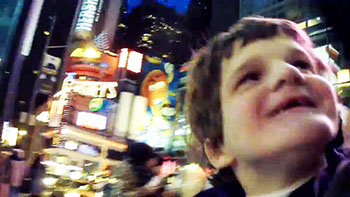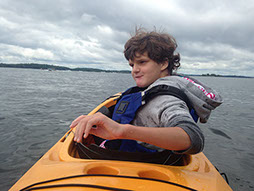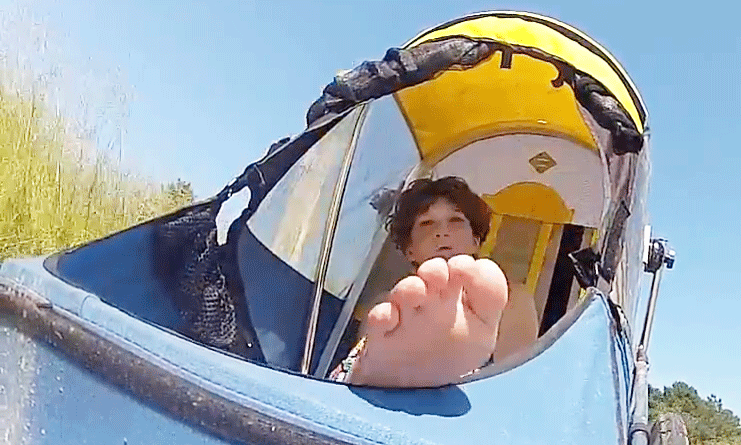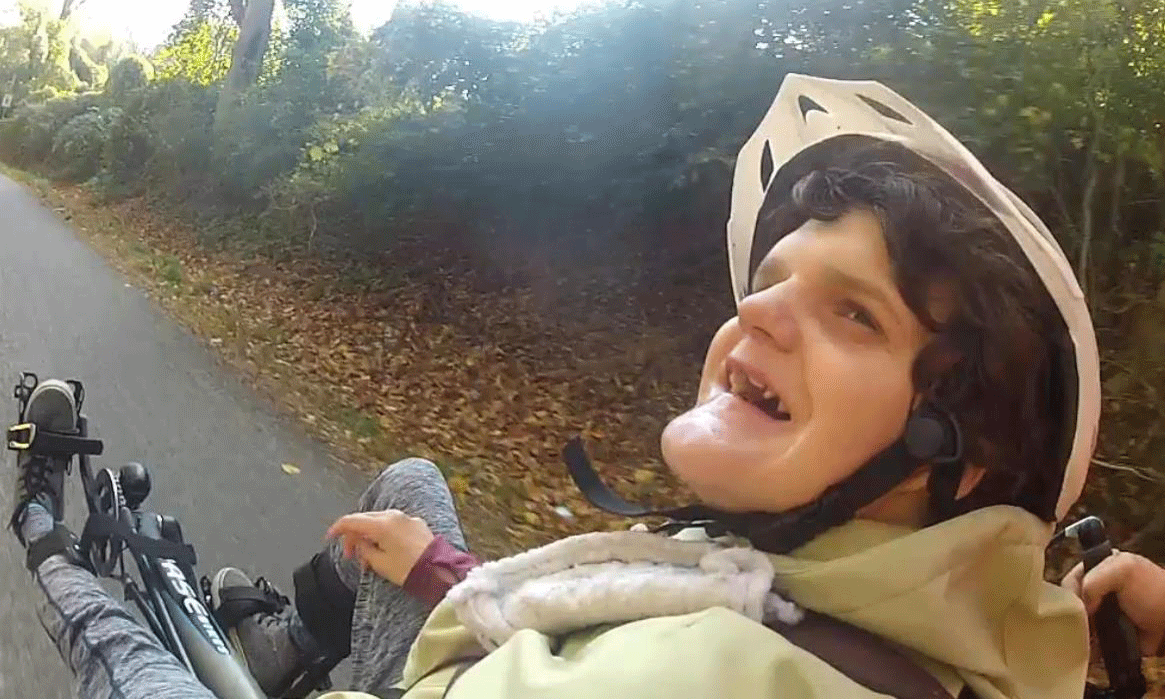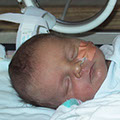 About Margot
About Margot
Born in 2000, Margot went straight into the NICU for a month
 GoPro Hero
GoPro Hero
Everyday, incredible
accomplishments captured on video
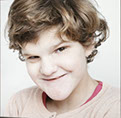 Smile!
Smile!
3 providers, 4 months, 5 appointments, too many phone calls, to fix 1 cavity
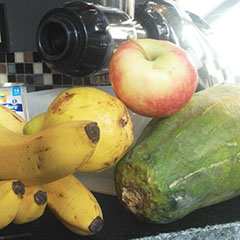 Real food, real meals
Real food, real meals
From drip-feeding a chemical blend to real food. Recipes included!
 No "Can't Do"
No "Can't Do"
A new video challenging assumptions about what Margot can enjoy and do.
 Siege or surrender
Siege or surrender
On a Christmas trip to the tropics, I waved a white flag to our new reality.
 Prisoner of Routine
Prisoner of Routine
Creating functional & fun routines took lots of effort but salvaged our sanity.
 Trail Adventures
Trail Adventures
A blog for the Rails to Trails Conservancy offers tips to help hit the trails.
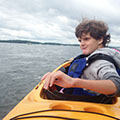 Leap of faith: Act I
Leap of faith: Act I
My hopes took a hit, so I needed inspiration to take risks again, like kayaking.
 Leap of faith: Act II
Leap of faith: Act II
Inspired to kayak? From idea to implementation, and a lesson for research.
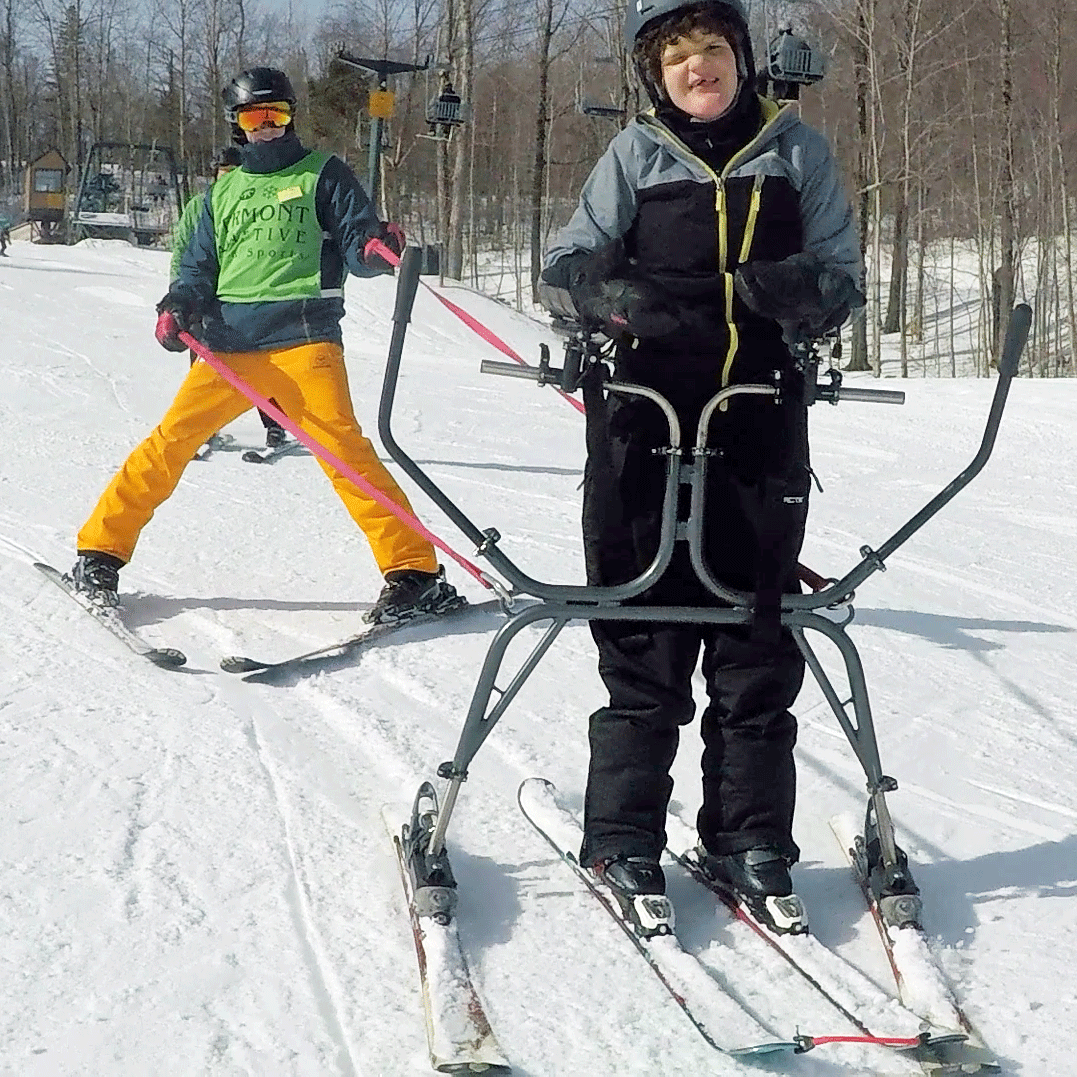 It's all downhill!
It's all downhill!
Can Margot learn to ski? With expert help and sensible teaching, yes!
 Best summer ever!
Best summer ever!
After 18 years, getting summer right for Margot and the whole family!
A leap of faith, into a river of possibilities
Act II: The Implementation
April 22, 2017
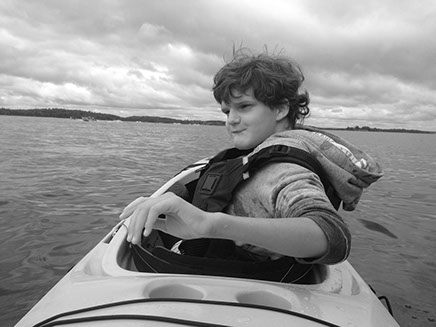 3. Good mood
3. Good mood![]() In the first act of this story, I took a leap of faith into a river, when I decided to attempt to kayak with Margot. In the process, I discovered that Margot also loved - and perhaps even needed - the thrill of stepping into the void. How rediscovering faith magically heals wounds and transforms lives in one simple step. End of story.
In the first act of this story, I took a leap of faith into a river, when I decided to attempt to kayak with Margot. In the process, I discovered that Margot also loved - and perhaps even needed - the thrill of stepping into the void. How rediscovering faith magically heals wounds and transforms lives in one simple step. End of story.
Or is it? Is a story that might offer inspiration to kayak enough to get you and your child into a river? Are you really ready to kayak with a child who cannot speak or swim, and who has limited mobility and eyesight? Perhaps inspired by your new faith in faith, you might think so. I sure hope not. And should you actually begin to plan this, you will agree. The inevitable cracks of doubt will widen into an implementation gap. Without more guidance, you will probably never kayak.
2. River calm
1. No rain
1+2+3+4= Good to Go!
4. Vest attached
My story of kayaking with Margot is absolutely true. The leaps of faith are real and important (more on that later). But we are addicted to these stories of inspiration. We search for the striking flash of insight or simple shift in attitude that helps us overcome adversity in a minute. The hook of healing. The tag line of transformation. A solution for everyone. The oh so American fable of fresh starts and unlimited potential.
There is a second act, a very different story of planning and implementation that is more cumbersome and complex but also more realistic. And perhaps more interesting (at least for some). How do you actually kayak with someone like Margot? The difference between inspiring someone to kayak and actually getting them into the water sheds light on another gap between what we imagine and what we actually make happen: the gap between ASD research, the practices implemented in the community, and outcomes people living with ASD actually achieve.
And what is a story without a final, surprising twist? A story of kayaking with Margot, in three acts.
From Idea to Outcome
The right place
If you are thinking of kayaking, your first decision is where to kayak. And your first consideration is always safety. There is too much to cover here, but consider this. Once you tip into the water, everything can go wrong with someone like Margot, even when everyone is wearing a lifejacket. A second pair of kayakers adds extra hands to help, and may be wise on your first forays, but is not always convenient. At some point, you will kayak alone with your child.
For example, should you tip, how do you right your kayak and then get back into it? Under the best of circumstances, this requires patience, strength, and finesse. But now you will be asking a child who understands few verbal instructions to do something new and difficult. An unexpected gulp of lake water, or splash of salt water in their eyes, and instead of choreographing your child's cooperation you will just be hoping to control their panic. The dangers from this point are very, very real.
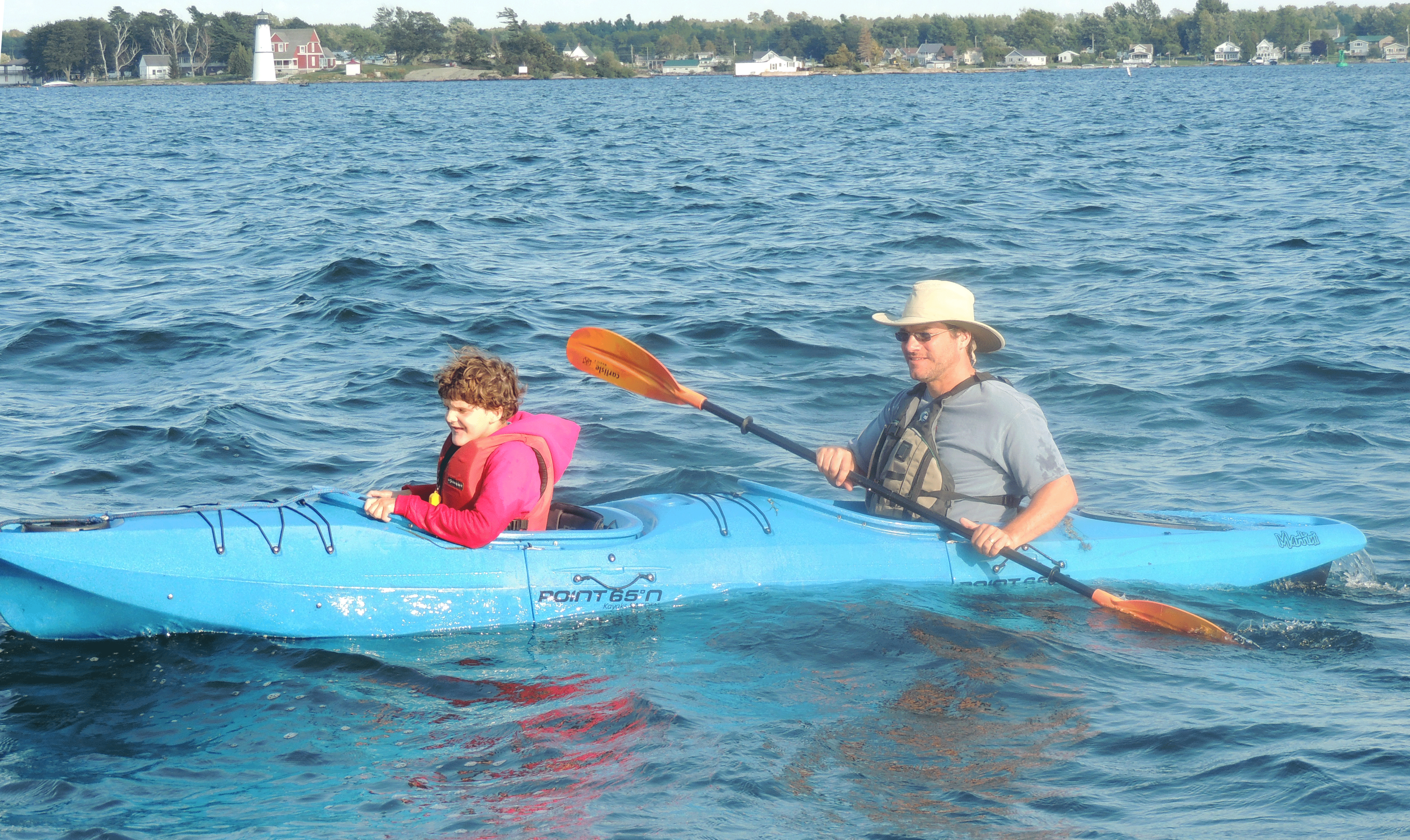 So most of you are now scared. Some may decide this is not for you, and that is ok. For the rest, a dose of paranoia about kayaking is probably healthy. In fact, when you stop feeling paranoid, you should probably stop kayaking. It is good to imagine what you would do if everything went wrong at the same time, because you will have to think and act for two people. Good preparation and ongoing vigilance is the key to prevention.
So most of you are now scared. Some may decide this is not for you, and that is ok. For the rest, a dose of paranoia about kayaking is probably healthy. In fact, when you stop feeling paranoid, you should probably stop kayaking. It is good to imagine what you would do if everything went wrong at the same time, because you will have to think and act for two people. Good preparation and ongoing vigilance is the key to prevention.
You can begin by choosing the right conditions to kayak.
- Lakes in state parks that offer boating are the safest option, and probably the best place to start. There are easy launch points, there may be other boaters, and you can get quickly to shore if the weather turns nasty. But as soon as you wander further from the dock, keep an eye on the shore: a steep muddy shoreline will prevent you from scrambling to safety. For example, Margot and I have enjoyed kayaking at Marsh Creek State Park 45 minutes from our house.
- I prefer kayaking on a river, but this brings other risks. Even a slow current will gain speed when it is squeezed between or over rocks. And a faster current can create all kinds of problems. It can easily tip an unstable kayak jammed against a rock. It quickly separates paddlers once in the drink. A child caught in a low branch can be quickly knocked out of a kayak or pulled under the water. The Brandywine is ideal, because it is slow AND shallow (it is knee deep in many spots). I will always find a time to try a new section of a river first without Margot, to anticipate problems with the launch, the trip, and the takeout. I have mapped out 6 sections of the Brandywine that can each be completed in 1 to 1 1/2 hours, without dams or rapids, and with relatively easy access.
- I have not tried kayaking in the ocean with Margot, and I am not sure I am eager to. There is often not a lot to see, and the stronger waves and currents can make anything but a short jaunt close to shore difficult and risky.
The right stuff
As every do-it-yourselfer knows, every new project is just an excuse to research and buy new stuff, some of which you might actually use. So when I started to wonder about kayaking, I started with the kayak. I began by believing that I needed a kayak that could comfortably accommodate two adults in addition to Margot, in case she ever tried to stand up while on the water.
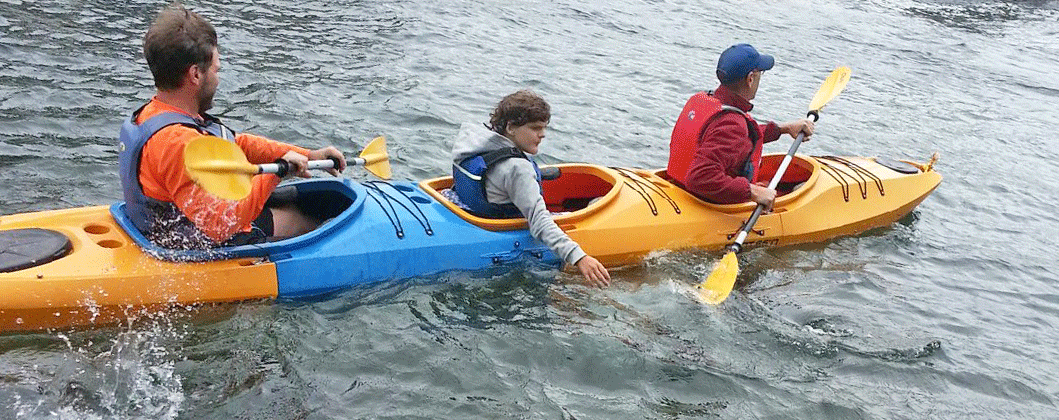 Another safety reminder: do not stand in a kayak. As a child, I once found myself dumped from a canoe down a rushing river into a small set of rapids. It was terrifying. I pulled myself out at the other end with bruises and scrapes, but even as an 8 year old I imagined much worse. As Margot's father, the possible outcomes I can imagine are far more terrifying. And so, fearful that Margot might try to stand up, I set out on a quest for the three person option illustrated above, and described later.
Another safety reminder: do not stand in a kayak. As a child, I once found myself dumped from a canoe down a rushing river into a small set of rapids. It was terrifying. I pulled myself out at the other end with bruises and scrapes, but even as an 8 year old I imagined much worse. As Margot's father, the possible outcomes I can imagine are far more terrifying. And so, fearful that Margot might try to stand up, I set out on a quest for the three person option illustrated above, and described later.
In hindsight, my paranoia was unwarranted, at least for Margot. I was surprised that she was so comfortable from the start. Perhaps her natural prudence was in play, and she has never tried to get up until I have prompted her. So lesson one: find a very shallow lake with a gentle beach, get a simple tandem, and try it out a couple of times. I would still recommend a sit-in rather than a sit-on kayak, as the additional effort to exit the former gives you a chance to intervene. Do not kid yourselves; rivers and lakes can quickly become dangerous, but that is usually because of poor planning not poor equipment.
Choosing the right kayak is important for other reasons.
- There are a couple of tandem kayaks that offer the option of a small child seat in between the paddlers, but these offer no back support. These will quickly become uncomfortable for your child within a few minutes, if they do not outgrow it beforehand.
- Tandem kayaks are not cheap: being able to look beyond the subset that offer a third seat saves you money, especially if you can pick up something used.
- Tandem kayaks are heavy and awkward to lift and transport; you want the freedom to choose the lightest kayak possible.
So lesson number two is that the means of transporting a kayak is as important as the kayak itself. Surprise number two? You are more likely to hurt yourself transporting than paddling your kayak. Other equipment and good planning can help, but it is oh so easy to wrench your back wrestling an 80 pound 14 foot tandem onto a beach or on top of a car. Especially after a long paddle or when you also have a restless child. And no more kayaking for you!
First, how will you get it onto your car? There are special lifts that drop down the side of your car so that you do not have to lift your kayak overhead, but these are expensive. I manage with some folding Thule racks on top of my SUV, and just make sure I take my time and check my footing. (The trick to getting my tandem kayaks 9 feet in the air on top of my high top van is another story!)
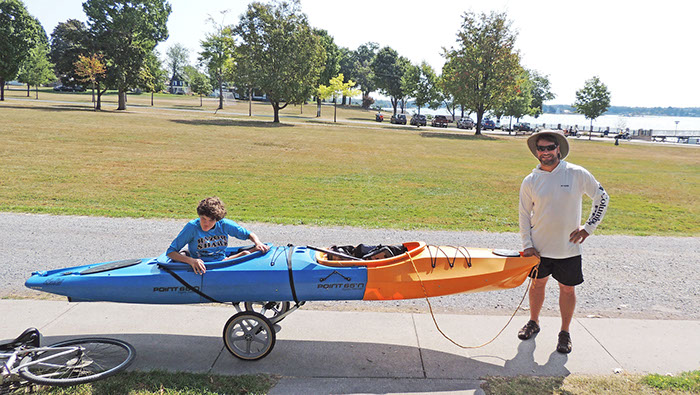 Second, how do you get the kayak from the car to the river? A boat launch on a lake offers an easy solution, but you probably have to cart your kayak at least 30 yards to launch into a river, even with the best planning. In typical circumstances, this is doable, but the need to monitor your child and carry ALL of their stuff too can leave you exhausted before you even set foot in the water. I was delighted to discover an ingenious tow-able kayak trailer from Wike that I can fold and tie on to the kayak. If the ground is level, I can make it all in a single trip even with Margot (see above).
Second, how do you get the kayak from the car to the river? A boat launch on a lake offers an easy solution, but you probably have to cart your kayak at least 30 yards to launch into a river, even with the best planning. In typical circumstances, this is doable, but the need to monitor your child and carry ALL of their stuff too can leave you exhausted before you even set foot in the water. I was delighted to discover an ingenious tow-able kayak trailer from Wike that I can fold and tie on to the kayak. If the ground is level, I can make it all in a single trip even with Margot (see above).
 My ultimately unnecessary search for a three person kayak led to a solution that might appeal to some; the modular kayak. I bought two Point65 Martini Tandem kayaks (one new, and one used). I can take the middle section from one and insert it into the other to create the three person kayak (illustrated in the beginning of this section). And I still have a single kayak left over! The lasting appeal is its portability: instead of wrestling a 14 foot 80 pound behemoth onto my roof, I can load it in two or three separate, easier to lift sections, as illustrated to the right. Each section is light enough that Margot's younger sister could carry it in a pinch. When I kayak on my own, the two sections of the solo kayak fit comfortably in my compact hatchback.
My ultimately unnecessary search for a three person kayak led to a solution that might appeal to some; the modular kayak. I bought two Point65 Martini Tandem kayaks (one new, and one used). I can take the middle section from one and insert it into the other to create the three person kayak (illustrated in the beginning of this section). And I still have a single kayak left over! The lasting appeal is its portability: instead of wrestling a 14 foot 80 pound behemoth onto my roof, I can load it in two or three separate, easier to lift sections, as illustrated to the right. Each section is light enough that Margot's younger sister could carry it in a pinch. When I kayak on my own, the two sections of the solo kayak fit comfortably in my compact hatchback.
Other essentials are less surprising, like life jackets and a good dry bag. My favorite: a favorite toy tied to a rope that Margot can throw into the water again and again (and again...).
The right plan
Another surprise was just how hard it was to find good launch sites for a river trip, especially for someone like Margot. Kayaking in a river requires parking and access that is appropriate for you and your kayak and your child. A trail fringed with nettles or a sloped muddy bank is no fun for one, and can become impossible if you are guiding someone with limited mobility at the same time. I sometimes shuttle between Margot and the kayak, bringing one down 10 to 20 yards and then the other, but every minute of frustration steals pleasure from the trip. A kayak trailer and a smooth trail erases many issues. The trips I have mapped out for Margot on the Brandywine include launch sites with parking and reasonable access.
A more pleasant surprise has been the pedal paddle, or trips that include biking and kayaking. Some state parks with lakes support both, but my favorites have been river trips, and these are detailed on Margot's map. These involve a 3 to 5 mile stretch of the Brandywine with good access and no dams. I drop my bike and Margot's Wike off at the take out point, then park my car upriver at the launch site, paddle for an hour or so to the take out point, wrestle the kayak from the water, pull my bike and Wike from the bushes, and cycle back to the starting point. Sometimes this involves biking on the road for 3-4 miles, which is ok if the road is not heavily trafficked, but can also involve trails or small country roads offering fresh perspectives as they parallel the river. I have mapped out 6 or so pedal paddles along different sections of the Brandywine, first running each new section alone to test each step.
Planning for pleasure
Attending to these details can distract from a larger goal: how activities like kayaking help to re-balance the quality of life left askew through disability. Though this lesson is described elsewhere on this site in stories of re-inventing our vacations and our other adventures, two insights are worth offering here.
 First, after planning for the worst, I discovered that Margot was remarkably accommodating and resilient. Perhaps the fun that Margot experienced or anticipated when kayaking mediated or moderated any frustration and anxiety she might experience on the way. So, as I cursed while slipping down a muddy bank, she laughed. As I wrestled her into the kayak, she wriggled as if tickled. Margot was not bothered being a bit wetter, colder, and muddier than usual. For her, it is just part of the adventure.
First, after planning for the worst, I discovered that Margot was remarkably accommodating and resilient. Perhaps the fun that Margot experienced or anticipated when kayaking mediated or moderated any frustration and anxiety she might experience on the way. So, as I cursed while slipping down a muddy bank, she laughed. As I wrestled her into the kayak, she wriggled as if tickled. Margot was not bothered being a bit wetter, colder, and muddier than usual. For her, it is just part of the adventure.
Technically, her rates of problem behavior tumbled during these trips, and stayed low unless she sensed that I remained frustrated about a problem I could not solve. Major variations in rates of problem behavior between more stressful environments (like the academic demands of school) and less stressful environments (like home) are common. But Margot's apparent understanding and resilience gave me room to find solutions to the inevitable snafus whenever we kayak.
Second, I discovered that these big adventures re-charged batteries drained by boredom. Summer is the worst, with a shorter school day and week bookended by long breaks at the beginning and the end of the season. I always plan on weekly biking or hiking adventures throughout the year, whenever the weather allows. But Margot needs extra excitement when school is out, and especially during summer breaks. These kayaking adventures are made for the dog days of summer, when a shady river offers respite from the heat of the afternoon. After Margot returns from one of these trips, she is just happy to chill for a day or two.
And these kind of adventures can be the key to re-inventing vacations that will work for someone like Margot. Routines carefully calibrated at home to keep children with disabilities engaged are hard to replicate on vacation, and disrupting these routines can stress everyone out. Long drives, with the added time needed to pack and unpack, are boring. But adding a kayaking adventure before, during, or after a trip inoculates against the effects of disruption and boredom. Kayaking is just one of the many adventures that Margot and I have discovered, and can now integrate into our vacations. This includes trail biking, and road biking with a specially adapted tandem bicycle. In a blog for the Rails to Trails Conservancy, I have drawn lessons from these adventures to share tips for families keen to hit the trails.
The implementation gap in kayaking and in ASD research
In an odd parallel, ASD research seems to offers a similar kind of inspiration: we cling to a faith that science can offer a quick solution. We just need to discover the one cause that leads to a cure, or gain insights into the one characteristic that unlocks the mystery, or discover the one treatment that can quickly alleviate every symptom in every child. The solution is always just around the corner, in the next research grant or the next journal article.
But is this inspiration deceiving? While we search for yet more inspiration, we miss the opportunities right in front of us to help those living with ASD right now - our students, our patients, our clients, our employees, our own children. Why? Because we do not know how to design the programs and policies needed to identify everyone living with ASD, let along deliver the treatments we already know to be effective. Or we just do not dedicate the resources to do so.
Whether we are talking about kayaking or ASD research, implementation is very different from inspiration. It requires work that can be long and hard, often tedious, and sometimes without clear outcomes. While many programs of research offer inspiration, most fail to provide any of the details needed for implementation. Does the research result in a specific recommendation regarding a specific practice? What meaningful outcomes can we measure? Which population is this practice relevant to? How do we integrate the practice into a specific service offered by a specific professional in a community-based setting? And how is all this payed for? And so implementation is left in the hands of those least trained to interpret the research: those living with autism, and the front-line professionals trying to help them. That is why, after three decades and billions of dollars spent on research, many people with ASD and related conditions are seeing little benefit in their day to day lives.
The pressure to write stories of inspiration that are quickly and easily digested is very real. The details required for successful implementation are not are easily described or digested. And the marvel of implementation - the detailed observation, meticulous planning, surprising solutions, careful adjustments, and long-term vision - will be lost on anyone who does not focus each day on directly educating, treating, or training people with ASD and the professionals who support them. Implementation is the stout, muddy draught horse that pulled the plow for hours on end to create the endless and beautifully straight rows of crops we came to depend on, not the sleek and graceful racehorse required only to complete a mile and a quarter in two minutes for the benefit of bettors with bucks to burn.
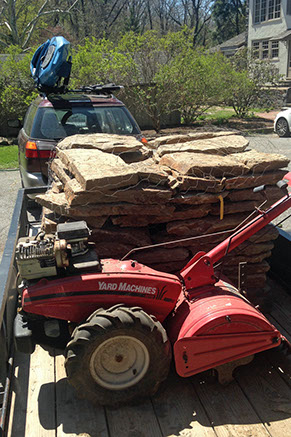 Maybe I am an just an oddity, a kind of implementation nerd. A doer more than a dreamer. After all, in my spare time, I like to figure out stuff. Sometimes I cannot choose between kayaking, laying stone, and tilling a field for a garden, as pictured here. Some of it turns out to be pretty useful, like how to prepare and deliver a diet of real food to replace the Pediasure Margot lived on for too many years, or mapping out the range of trail adventures in our region. Some of it turns out to be pretty useless, like watching youtube videos of people trying to convert lawnmowers and weedwhackers into leaf shredders. Though I ended up just buying a chipper/shredder in the end, I did marvel at the countless whacky inventions, and did wonder how many fingers and eyes were lost in the videos that never made it to screen.
Maybe I am an just an oddity, a kind of implementation nerd. A doer more than a dreamer. After all, in my spare time, I like to figure out stuff. Sometimes I cannot choose between kayaking, laying stone, and tilling a field for a garden, as pictured here. Some of it turns out to be pretty useful, like how to prepare and deliver a diet of real food to replace the Pediasure Margot lived on for too many years, or mapping out the range of trail adventures in our region. Some of it turns out to be pretty useless, like watching youtube videos of people trying to convert lawnmowers and weedwhackers into leaf shredders. Though I ended up just buying a chipper/shredder in the end, I did marvel at the countless whacky inventions, and did wonder how many fingers and eyes were lost in the videos that never made it to screen.
So Act Two, the story of how I actually learned to kayak with Margot, might not be as inspiring, but it is certainly instructive. And for fellow implementation nerds, maybe even intriguing.
Act 3: The paradox of planning
So we have the place, the equipment, and the plan. We are ready to go, right? Maybe not yet.
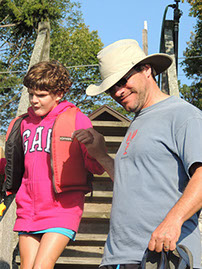 The most diligent, most meticulous planning by the most obsessive person will never quell all possible fears or protect against all possible failures. The paradox here is that the final step in your wonderful plan to kayak is a reprise of the first step of your journey, a step you can never plan for: the leap of faith. In this anti-plan, you accept that there still might be some things you did not or could never plan for. You can minimize many odds, but you can never completely negate them. At a certain point, you just have to trust that you will be able to figure it out on the fly.
The most diligent, most meticulous planning by the most obsessive person will never quell all possible fears or protect against all possible failures. The paradox here is that the final step in your wonderful plan to kayak is a reprise of the first step of your journey, a step you can never plan for: the leap of faith. In this anti-plan, you accept that there still might be some things you did not or could never plan for. You can minimize many odds, but you can never completely negate them. At a certain point, you just have to trust that you will be able to figure it out on the fly.
I have seen a range of similar fears in those considering the leap to implement a new ASD program or new intervention. ASD researchers with no training or limited experience in actual treatment control these fears by approaching implementation with the utmost caution. And so they tend to test specific interventions targeting very specific skills only under highly controlled circumstances (i.e., with a very specific population, and often in a specialized setting). This helps to ensure that they will demonstrate some effect of treatment, but often at the expense of any immediate potential for a broad impact in the real world. At the other end, even experienced, community-based program leaders often hesitate to let go of a familiar ASD treatment to try something demonstrably more promising.
As an ASD researcher and a program leader, my own fears have became outweighed by the knowledge that we can do so much more for so many more people with ASD, and the responsibility we have to do so. We cannot hold their future hostage to our own fears of failure. At a certain point, we just have to trust that we will run into problems rolling out new practices and programs, and that we will be able to figure it out on the fly. We can plan all we want, but the final step is a leap of faith.
Kayaking offers some helpful lessons for parents of children with disabilities who are struggling with similar doubts and fears. For some hesitating to take the final step in trying something new and risky, this leap of faith might involve some kind of call to some kind of higher power. Those less spiritually inclined might just have to be inspired by others with a "No can't do" attitude. Or maybe it was so quick, you leapt before you could even think. Whatever form this leap takes, it is the first step towards rediscovering the trust and belief that just maybe you, your child, and your future together will turn out ok, at least this time.
The first time Margot and I kayaked in the St. Lawrence River, I had such a great plan that I could not imagine needing such faith. After all, we had already kayaked successfully on he Brandywine river. I had figured out where we would go in the St. Lawrence, when the conditions were right, how I might film it, and then did a test run by myself. Then I set up the camera, and Margot's beloved nanny and I brought her down into the dock pictured below. And then I discovered the step I had not planned on: getting her from the dock into the kayak. Margot had always just stepped right into the kayak so easily from a beach.
 The subsequent struggle captured on film is funny to watch. I stand on the dock and start to lift Margot into the kayak. Then the kayak starts to drift away, Margot's feet get dumped into the water, and I feel my grip slipping. I try this two or three times, cursing under my breath while her nanny looks on worriedly and offers a hand. I distinctively remember thinking that maybe this was not such a great plan: I could easily lose my balance or drop her in the river or let the kayak drift beyond reach. All captured on film
The subsequent struggle captured on film is funny to watch. I stand on the dock and start to lift Margot into the kayak. Then the kayak starts to drift away, Margot's feet get dumped into the water, and I feel my grip slipping. I try this two or three times, cursing under my breath while her nanny looks on worriedly and offers a hand. I distinctively remember thinking that maybe this was not such a great plan: I could easily lose my balance or drop her in the river or let the kayak drift beyond reach. All captured on film
But on the fourth try, before these doubts and fears took over, I got a better grip, and just kind of dropped her into her seat with a resounding thunk and a splash. That was that. Margot smiled and cooed and dipped her hand in the water, and we were off. One small leap of faith for me. One giant leap of faith for our future of fun together.
Other Related Content
 About Margot
About Margot
Born in 2000, Margot went straight into the NICU for a month
 GoPro Hero
GoPro Hero
Everyday, incredible
accomplishments captured on video
 Smile!
Smile!
3 providers, 4 months, 5 appointments, too many phone calls, to fix 1 cavity
 Real food, real meals
Real food, real meals
From drip-feeding a chemical blend to real food. Recipes included!
 No "Can't Do"
No "Can't Do"
A new video challenging assumptions about what Margot can enjoy and do.
 Siege or surrender
Siege or surrender
On a Christmas trip to the tropics, I waved a white flag to our new reality.
 Prisoner of Routine
Prisoner of Routine
Creating functional & fun routines took lots of effort but salvaged our sanity.
 Trail Adventures
Trail Adventures
A blog for the Rails to Trails Conservancy offers tips to help hit the trails.
 Leap of faith: Act I
Leap of faith: Act I
My hopes took a hit, so I needed inspiration to take risks again, like kayaking.
 Leap of faith: Act II
Leap of faith: Act II
Inspired to kayak? From idea to implementation, and a lesson for research.
 It's all downhill!
It's all downhill!
Can Margot learn to ski? With expert help and sensible teaching, yes!
 Best summer ever!
Best summer ever!
After 18 years, getting summer right for Margot and the whole family!


